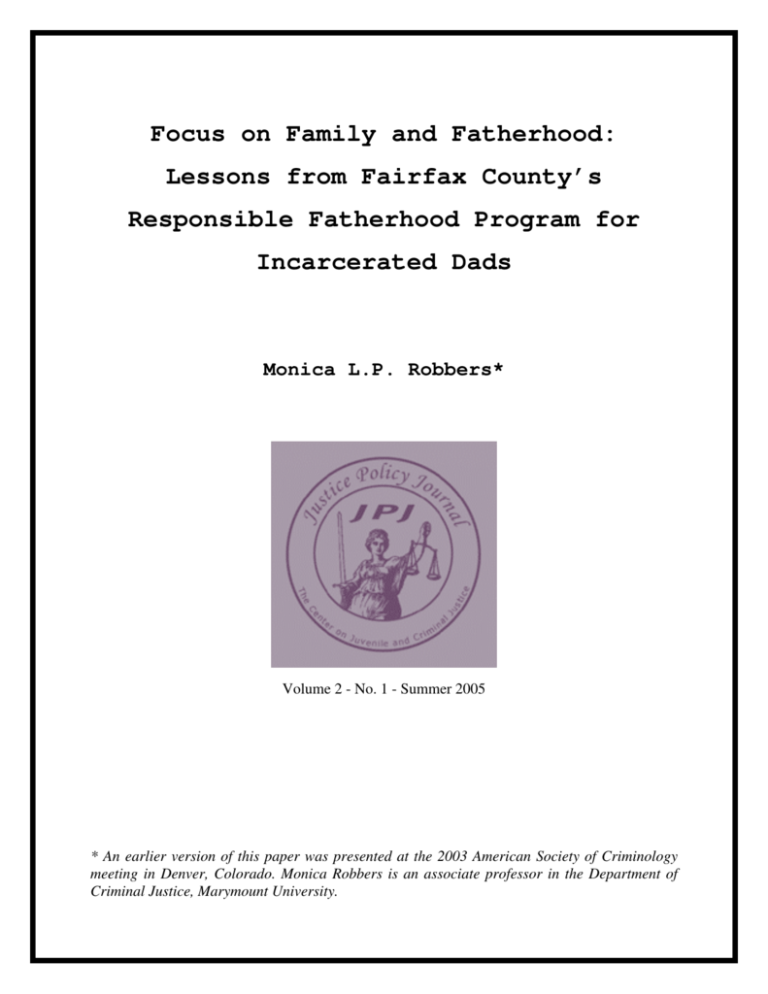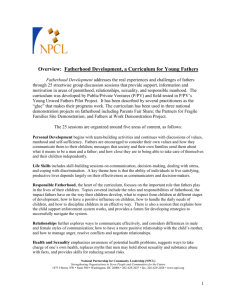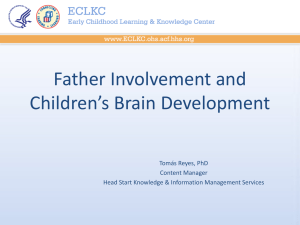Focus on Family and Fatherhood: Lessons from Fairfax County's
advertisement

Focus on Family and Fatherhood: Lessons from Fairfax County’s Responsible Fatherhood Program for Incarcerated Dads Monica L.P. Robbers* Volume 2 - No. 1 - Summer 2005 * An earlier version of this paper was presented at the 2003 American Society of Criminology meeting in Denver, Colorado. Monica Robbers is an associate professor in the Department of Criminal Justice, Marymount University. Abstract During the next five years, researcher’s estimate that some 10 million children under the age of 18 will have a father who is incarcerated (DOJ, 2003). Children who grow up without a father are five to six times more likely to live below the poverty line, are at increased risk of substance abuse, physical and emotional abuse, and are more likely to become involved in the justice system themselves. In an effort to re-connect children with estranged or absent fathers, Responsible Fatherhood programs have been implemented in prisons and communities around the country. In March of 2002, Fairfax County implemented a Responsible Fatherhood program for incarcerated Dads. This article presents quantitative results from the evaluation of the first six cohorts to complete the program, using a classic four group experimental design. The program’s effectiveness in building family relationships, increasing knowledge and improving attitudes toward fatherhood, improving the quality of relationship with mother’s of children, and increasing awareness of the justice system are discussed, along with other program benefits, and recommendations for future programs. 2 Focus on Family and Fatherhood: Lessons from Fairfax County’s Responsible Fatherhood Program for Incarcerated Dads Introduction During the year 2000, some 1.5 million children had parents incarcerated, and 667,900 of these incarcerated parents were fathers (Gaes and Kendig, 2003; Mumola, 2000). The effects of father absence have been well documented in research and include an increased risk of poverty, substance abuse and intergenerational criminal involvement; and a decrease in ability to cope with trauma, a disruption of development, and erosion of respect for authority figures (Anderson, Kohler and Letiecq, 2002; Bilchick, Seymour and Kreisher, 2001; Garry, 1997; Travis, Cincotta and Solomon, 2003; Turner and Peck, 2002). The increase in the number of fathers who are incarcerated is a reflection of “get tough” policies on crime, that have mandated longer and tougher sentences and an attitude of retribution and incapacitation (Shichor, 2000). This tough approach to crime fails to provide measures for the vast majority of prisoners who will be released back into communities and are expected to live law-abiding lives. The need for transitional, life skills, and education programs should be a priority in an effort to reduce recidivism rates, build community networks, and strengthen families. Despite recidivism rates of between 65 and 80 percent, prison programs are actually on the decline (Mears et al., 2002; Travis, Concotta and Solomon, 2003). Further, evaluations of programs that do exist are few and far between. Mears et al., (2002) report that in 1991, 43 percent of inmates participated in some kind of educational program. However, by 1997, only 35 percent of inmates were participating in programs. Pre-release programs are currently being offered to only about 10 percent of inmates nationally. 3 In an attempt to educate incarcerated fathers about child development and fathering, and re-kindle child / father relationships, Fairfax County, in northern Virginia, piloted a responsible fatherhood program that began in 2002. This program is being run by the Department of Community Corrections. This article presents quantitative results from an evaluation of the first six cohorts to complete the program, using a classic four group experimental design. The program has four outcome variables that are assessed: 1) contact with children; 2) knowledge and attitudes toward fatherhood; 3) quality of relationship with mothers of children; and 4) knowledge of the justice system. Background on Fatherhood Programs In the United States, many of the responsible fatherhood programs offered in communities and jails and prisons are sponsored by the National Fatherhood Initiative (NFI), or by religious organizations. However, very little has been published about these programs and few evaluation studies have been conducted (Anderson, Kohler and Letiecq, 2002; Cabrera and Peters, 2000; and Hairston, 1989). Program evaluation is essential in identifying program shortcomings and strengths, exchanging ideas, and perhaps most importantly in the corrections arena, to help erode Martinson’s long lived legacy of “nothing works” (Martinson, 1974). Fatherhood programs have the potential to improve the lives of incarcerated fathers and reduce recidivism (Horn, 1999). Fatherhood programs can also restore family bonds or at least repair them, and children are more likely to become productive citizens if they have a good relationship with their fathers. The greater benefit from these programs is that communities can become more stable, both financially and emotionally. Hairston (1988 and 1991) and others have also found evidence to suggest that maintaining family bonds is a strong predictor of successful transitions from prison to society (see also Slaght, 1999). 4 In a report released by the Bureau of Justice Statistics in 2000 detailing results from interviews of parents in prison, 22 percent of incarcerated parents said they kept in contact (usually by mail) with their children once per month, 16 percent said contact occurred less than once per month, and 20 percent said they had no contact with their children. Further, more than half of incarcerated parents (57 percent) had never seen their children (Mumola, 2000). By ethnicity, there are other concerns for the well being of the family. Forty seven percent of incarcerated parents are African American, indicating that some seven percent of African American children in the United States have a parent in prison (Mumola, 2000 as cited in Parke and Clarke-Stewart, p. 191, 2003). Parke and Clarke-Stewart suggest that these statistics highlight the need for jails and prisons to focus more on families (2003). Among the very few published evaluation studies of fatherhood programs is Hobler’s (2001) evaluation of a fatherhood program being conducted in Delaware prisons. The participants in this program have either been convicted of child abuse, assault or endangerment, or have children who are minors. The evaluation consists of pretests that measure knowledge of parenting and post-program questions that ask participants to evaluate the program and the program facilitator. Results from this study indicate that knowledge of parenting was significantly increased through participation in the program, and that all participants felt the program was worthwhile. Hobler suggests that program participation become a mandatory part of sentences for fathers, prisons should develop special child visitation periods, and continued participation in a fatherhood program be a condition of probation or parole. Hobler also identifies the need for longitudinal data so that the long-term effects of fatherhood programs can be examined (p. 113). 5 In an article that examines the impact of the Long Distance Dads (LDD) program implemented in a prison located in Albion, Pennsylvania, anecdotal accounts from some of the 600 inmates who have completed the program suggest that the program has long lasting and far reaching positive consequences for incarcerated fathers (Turner and Peck, 2002). Evaluation Research in Correctional Settings Evaluations of prison based programs are rare (see author cite, 2003 for discussion). Tewksbury and Mustaine (2001) found that of the articles published in the six main correctional journals between 1990 and 1999, only 6.9 percent were program evaluations. The main issue that potential researchers face is that the evaluation process needs to be short and long term, given that the offenders must be tracked post-release in order for the long term effects of the program to be measured. A second problem is how success of a program should be measured. Using the sole outcome variable of recidivism may miss many “successes” in a program, such as those individuals who kick a substance abuse habit, or those offenders who establish solid relationships with family members. Contributions to the community may be made by offenders, and this is also very hard to capture. A third obstacle is funding. In a time when funds for programs are stretched, an evaluation study is often a last priority. Withrow (2002) criticizes oft-used methodology in evaluation studies of correctional programs, citing lack of scientific rigor. Withrow advocates the use of a four group experimental design as it allows for more sophisticated statistical analysis of data, and can isolate pre and posttest effects so that tracking offenders once they have been released in order to fully assess the short term impact of a program, is not necessary. However, unless the posttest is repeated at various time intervals, the design still fails to account for the long term impact of correctional programs. 6 The Fairfax County Program This program was launched in March 2002 by the Office of Community Corrections, which falls under the jurisdiction of the Fairfax County Office of the Sheriff. The director of Community Corrections was instrumental in developing and implementing this program. The facilitators for the fatherhood sessions are volunteers from a local nonprofit organization called Opportunities, Alternatives and Resources (OAR), who first complete a training session with the director of community corrections. As a result, the program operates almost cost-free. Program sessions are conducted in the pre-release center. This facility normally houses inmates from several local counties who are either at the end of their sentences or are participating in a work release program. Due to uncontrollable administrative issues, there are also inmates being housed here who are just beginning their sentences. The participants in the program come from the pre-release center, and from the county jail. The following are among the objectives of the Fairfax responsible fatherhood program: I. II. III. IV. V. VI. VII. VIII. Promote responsible fatherhood both during and upon release from incarceration; Encourage fathers to get involved in their children’s lives; Teach parenting skills; Provide an understanding of child development and the role that fathers play in this; Define responsible fatherhood; Promote emotional, moral, spiritual and financial responsibility for children; Teach the value of positive communication between parents; and Teach methods of minimizing parental conflict. These objectives are met during a ten-week program. Participants meet once per week for about 90 minutes. The curriculum covers statistics about fatherhood and parenting, understanding child development, co-parenting, responsible manhood, conflict resolution and moving on. Each lesson has homework components that participants are required to complete. These homework exercises usually involve some interaction with participants’ children. For example, at the 7 beginning of the program, participants are presented with a check list of questions about their children to which they must find the answer, such as “what is my child’ s favorite color?” “Does he or she have a favorite animal? Why?” Later in the program, participants write a letter to their children telling them how much they mean to them and share with their children their personal creed, which is developed during the program. During the course of the program, participants are also required to keep a journal in which they reflect on the classes and contact they have with their children. During the very first meeting, the importance of the group is established, along with the idea that the group will serve as a support network and participants should respect one another’ s ideas and experiences. Participants are also asked to sign a contract indicating their commitment to the group for the required time period. Like other responsible fatherhood programs, the role of the facilitator in the Fairfax program is to keep the group task-oriented without stifling discussion (see Hobler, 2001). Task orientation is crucial to this group as discussion can easily become a gripe session. Although there were male and female facilitators of various ethnic and racial backgrounds, it was discovered that facilitators who worked best with groups were men of the same ethnicity and race as most of the participants. The Fairfax fatherhood program is unique because it caters to fathers who are beginning their sentences, but it also includes some fathers who are about to be released. Targeting new inmates allows the importance of family to be established at the outset of incarceration and family bonds can, therefore, be maintained. Other programs often target fathers who are well into their sentences or who are about to be released. Participation in the program is voluntary. 8 Data Collection A classic four group experimental design was used in this study and is part of a larger evaluation process that also included focus groups. The entire evaluation of the fatherhood program is based on a model developed by researchers at Johns Hopkins University and the Lewin Group (Barnow and Stapleton, 1997). At this stage, the study design is cross-sectional, although these six cohorts will be followed for several years so the long term effects of the program can be evaluated. The treatment group in this study is those fathers who participated in at least four of the fatherhood program sessions. Eighty eight percent of the treatment group fit into this category. The control group is made up of fathers who were incarcerated for the length of the program. Control group members had to agree to participate in both pre and posttests. Although we would have liked to been able to employ matching in our experimental design, obtaining a control group was in itself a challenge, mainly because no concrete incentives for participation were being given. Participation in both the treatment and control groups was invited based on the desire to improve the program for future participants and to respond to incarcerated fathers’ needs. As a result, we relied a great deal on the knowledge and expertise of the director of Community Corrections for obtaining participants in both study groups. It is important to note that the director of Community Corrections is very well respected among the inmates, has very good rapport with all the men in this study, and the study participants feel at ease in his presence. The director is generally viewed by inmates as an advocate for inmate rehabilitation. The fatherhood facilitators had been working at the jail for some time, and so also were familiar to all the study participants. The principal researcher also had met with the treatment group on several occasions, and the research assistant is a volunteer 9 at the jail and was recognized by many of the participants. All study participants were given an informed consent agreement and were assured that failure to participate in the study would not affect the way their cases are handled. A pretest was distributed to the treatment group during the first session of the fatherhood program and the same pretest was distributed around the same time to the control group. During the final session of the fatherhood program, a posttest was distributed to the treatment group and the same test, minus questions that asked about the program, was given to the control group. Analytic Strategy Descriptive statistics will be presented for all variables. Analysis then centers on four research questions. First, we test whether the control and treatment groups are comparable by assessing demographic characteristics of the two groups. Second, analysis is conducted to ascertain whether there are differences in the two groups and across time on the four dependent variables. Third, assuming there are differences found, analysis will be conducted to determine whether participation in a greater number of program sessions significantly impacted posttest scores on the dependent variables. Last, differences in scores on the main study variables for fathers incarcerated for custodial and non-custodial offenses will also be examined. Demographic Variables and the Participants A number of control and demographic measures were included in this study. These were education level, annual income prior to incarceration, marital status, number of children fathered, number of mothers of children, type of offense (custodial verses non-custodial offense), and whether the subject held a valid driver’ s license. Included in the pretest was a question that asked subjects whether any of their children had witnessed their arrest. This question was posed given the likelihood that witnessing the arrest 10 may damage the relationship between parent and child (see Braman and Wood, 2003 for discussion). Given that recent research has also indicated that incarcerated men are reticent to speak to others about problems with relationships, children etc., (see author cite, 2003) we also included several items in the posttest that asked subjects about their interaction with other fathers in the jail. Examples of these items were: “ I have learned that other father’ s in the program have faced the same problems I have,” and “ I have learned techniques to help solve conflicts.” Also included in the posttest were questions that addressed the needs of father’ s upon release. Several closed and open-ended items were posed, such as “ I think there is a need for fatherhood support groups in the community,” and “ what community resources would help you as a father once you are released?” The Treatment Group The sample for the treatment group was participants in the first six program cohorts. The total number of inmates who participated in the first six cohorts was 72, but several did not complete the minimum four sessions, or were not present during either the pre or posttests, reducing the treatment group to 56. They ranged in age from 20 to 49 (M = 33.66; SD = 6.68). Twenty one percent of the participants had some high school, 48 percent had graduated high school or had obtained a GED, a further 21 percent had some college, and the remaining nine percent had either associates or bachelor’ s degrees. Twenty seven percent of the treatment group identified themselves as white, 64 percent as black, five percent as Hispanic and 1.8 percent as Asian or other race. In terms of income, 52 percent of the program participants made less than $30,001 per year and only 12 percent made more than $50,000. The current median level income for Fairfax 11 County is $81,050 - the second highest income level by county in the United States (U.S. Census, 2000). More than half of the program participants, 59 percent, reported having lost their jobs since incarceration, and only 28 percent had a valid driver’ s license. Fifty nine percent of the program participants are incarcerated for custodial offenses. The participants in these first six cohorts have an average of two children each (SD = 1.21), with the number of children ranging from one to six. Forty six percent of these men are single, 25 percent are currently married, five percent are widowed, and 23 percent are divorced or separated. Of the 56 men in this treatment group, 49 percent attended all the program sessions, 27 percent attended five or six sessions, and 23 percent attended four sessions. Control Group Fifty men were originally included in the control group, but a number of men could not be located at the time of the posttest because of early release or work release. Several posttests were incomplete and had to be discarded, bringing the final group size to 31. The age of the participants in the control group ranged from 20 to 54 (M = 34.46; SD = 7.79). Twenty nine percent of the control group participants had some high school, 29 percent had graduated high school or earned a GED, 29 percent had some college, three percent held associates degrees, and 9.7 percent reported having a graduate degree. Thirty eight percent of the control group identified themselves as white, 42 percent as black, and 19 percent as Hispanic. Similar to that reported for the treatment group, in terms of income, almost half of the control group reported earning $30,001 or less annually and only six percent reported earning more than $50,000. Fifty percent of the control group had lost their job because of incarceration 12 and 54 percent of the control group reported having a valid driver’ s license. Forty eight percent of the control group is incarcerated for custodial offenses. Participants in the control group have an average of 2.75 children (SD = 1.10), with the number of children again ranging from one to six. Twenty six percent of the control group members are single, 26 percent are currently married, and 48 percent are divorced or separated. Comparison of Offenders in Treatment and Control Groups In order to ascertain whether the control group and the treatment group are comparable, we tested whether there were any differences in the demographic and control variables between the two groups. Statistics are presented in Table one below and indicate that the two groups differ significantly on only two variables. First, significantly more control group members have valid driver’ s licenses than do treatment group members, and second, there are significantly more single men in the treatment group and significantly more divorced or separated men in the control group. Differences between the two groups in being able to legally operate a vehicle, is not likely to affect the results of this study since all the participants are incarcerated. This factor could affect longitudinal results given that upon release, men with driver’ s licenses will have one less hurdle to clear when it comes to contact and involvement with their children. Differences in the two groups marital status is also not likely to be problematic, but it may represent a lower level of commitment demonstrated by the treatment control as more of these men with children had never married. Integrity of Experimental and Control Conditions Maintaining the integrity of a social science experiment is typically more challenging than maintaining integrity in a laboratory setting since social settings are difficult to control (see Babbie, 2004 for discussion). Although we have ascertained that the treatment and control 13 groups are equivalent across almost all the variables, there is still the issue of diffusion of treatment across the two groups, which is a threat to internal validity. Table One: Comparison of Offenders in Treatment and Control Groups Demographics Control Group Treatment Group (n = 31) (n = 56) % or Mean SD (N) % or Mean SD Age ( in years) 34.47 7.79 (30) 33.67 6.68 Race White African American Hispanic Asian Other Education Some high school Graduated High School / GED Some College Associates Degree Bachelors Degree Income Less than $10,000 $10,001 to $20,000 $20,001 to $30,000 $30,001 to $40,000 $40,001 to $50,000 more than $50,001 Marital Status Single * Married Widowed Divorced / Separated * Number of Children Number of Mothers Child Witnessed Arrest Yes No Lost Job Since Incarceration Yes No Valid Driver’ s License Yes* No Type of Offense Custodial Non-Custodial (N) (56) 38.7 41.9 19.4 0 0 (12) (13) (6) (0) (0) 26.8 64.3 5.4 1.8 1.8 (15) (36) (3) (1) (1) 29 29 29 3.2 9.7 (9) (9) (9) (1) (3) 21.4 48.2 21.4 7.1 1.8 (12) (27) (12) (4) (1) 6.5 6.5 29 35.5 16.1 6.5 (2) (2) (9) (11) (5) (2) 10.7 17.9 23.2 23.2 10.7 12.5 (6) (10) (13) (13) (6) (7) 25.8 25.8 0 48.4 2.75 1.35 (8) (8) (0) (15) 46.4 25.0 5.4 23.2 2.10 1.48 (26) (14) (3) (13) 1.10 0.56 1.29 0.77 29 67.7 (9) 16.1 (21) 78.6 (9) (44) 48.4 48.4 (15) 62.3 (15) 37.7 (33) (20) 54.8 41.9 (17) 28.6 (13) 66.1 (16) (37) 48.4 51.6 (15) 58.9 (16) 41.1 (33) (23) * p <0.05; ** p <0.01 14 In this case, if fathers who were participating in the program had spoken with fathers in the control group, the results on the posttest could be compromised.1 In order to get some sense of whether this was happening, a question was included in the posttest that asked both groups of fathers if they had spoken to other fathers about fathering issues. Members of the control group were asked if they had spoken to any fathers who were in the program, and the treatment group members were asked if they had spoken to fathers about the program that were not participating in the program. This approach was also used by Feder and Dugan (2002) in their analysis of court mandated counseling for domestic violence offenders. Results indicated that only nine percent of the treatment group had spoken to fathers outside of the program, but 94 percent of the treatment group had spoken to each other about the program outside of the sessions. Only two fathers in the control group (6.4 percent) said they had spoken to treatment group members about the program. Given these results, we felt that diffusion of treatment had been kept to a minimum. Dependent Variables Frequency of Contact The first dependent variable included in this study is the frequency of contact subjects had with their children prior to, and during incarceration. At the pretest, subjects were asked how often they saw, spoke to, or wrote to their children. At the posttest, the same items were used, but items were phrased in relation to the program. Responses were scored on a four-point scale ranging from never to more than four times per month. Scores were then added to make a composite score of frequency of contact. Cronbach’ s alpha for this scale was 0.81 at the pretest and 0.79 at the posttest. 15 Knowledge and Attitudes about Fatherhood The second dependent measure in this study was knowledge and attitudes about fatherhood. This measure was developed using the Adult-Adolescent Parenting Inventory (AAPI) developed by Bavolek, Kline and McLaughlin (1979). Seven items were used to measure this variable, and responses were scored on a five point Likert scale ranging from strongly agree to not applicable. Examples of items are “ I know a lot about the effects of fatherlessness on children” and “ father absence has a negative impact on most children’ s development.” Responses to items on the pre and posttest were added to form two composite scales with high scores on the scales indicating a high level of knowledge and positive attitudes of fatherhood. Cronbach’ s alpha for this scale at the pretest was 0.84 and 0.83 at the posttest. Quality of Relationship with Mother The third dependent variable in the study was a measure of the quality of the relationship with the mother or mothers of the subject’ s children. Four items were posed pre and posttest on the same Likert scale as the variable knowledge and attitudes of fatherhood. Examples of items are “ My relationship with the mother of my children is friendly,” and “ the mother of my children makes it uncomfortable for me every time I pick up my children.” Again, responses from these items were added to form a composite score, and a high score on the scale indicates a positive relationship with the mother. Cronbach’ s alpha for this scale at the pretest was 0.71 and at the posttest 0.73. Knowledge of Justice System Since the program was initially developed for fathers who were incarcerated for failure to pay child support, a variable was included to measure subjects’ knowledge of the justice system, specifically custodial issues. Four items were posed pre and posttest and were scored on the same 16 five-point Likert scale as above. Responses to items were added to form a composite score and a high score on the scale indicates a high level of knowledge of the justice system. Examples of items are “ I can’ t seem to get consistent information about child support payments,” and “ I know who to call to have my support payments adjusted if my employment status changes.” Cronbach’ s alpha for this scale at the pretest was 0.68 and at the posttest was 0.69. Results Table two below reports average scores of the five dependent variables for each group and over time (pre and post). T-tests were used to assess whether there were differences between groups and between groups over time. Frequency of Contact The average score for frequency of contact on the pretest did not vary significantly by group. Across time, there was a significant increase in average scores for the treatment group (t = -3.04; p<0.05), while the control group scores increased slightly, but not significantly. This suggests that the program did have a significant impact on increasing father’ s contact with their children. Knowledge and Attitudes toward Fatherhood Scores measuring knowledge and attitudes toward fatherhood did not vary significantly by group. Across time, there was a significant, and large increase in average scores for the treatment group (t = -16.89; p<0.05) suggesting that the program is impacting how much father’ s know about psychological and physiological development of children. Scores for the control group did not vary significantly across time. 17 Quality of Relationship with Mother As with previous dependent variables, there were no differences in average scores across groups for quality of relationship with mother. The average score for quality also was not significant for either the treatment or control group across time. This result indicates that the program needs to focus more attention on relationships between the parents of children; this issue will be re-visited in the discussion section. Knowledge of the Justice System Average scores for knowledge did not significantly vary across groups. Across time there was a significant increase for the treatment group (t = -2.88; p<0.05), but not for the control group, indicating that the program is improving awareness and knowledge of the justice system. Analysis of scores by the number of sessions attended Given that average scores on three of the four dependent variables for the treatment group were significantly improved from pre to posttest, further analysis was conducted on these scores to ascertain whether those improvements were related to the number of program sessions that subjects attended. Results for this analysis appear in Table three.2 Table Two: Dependent Variables by Group and Over Time Variable Group Pretest Mean Posttest SD (N) Mean SD (N) Difference Tscores Frequency of Contact Treatment Control 6.07 5.77 3.66 (52) 3.22 (30) 7.94 6.43 2.17 (52) 3.05 (30) -3.04 ** -0.87 Knowledge and Attitudes toward Fatherhood Treatment Control 6.50 5.54 2.31 (56) 1.98 (31) 12.66 6.09 2.26 (56) 2.39 (31) -16.89 ** -1.22 Quality of Relationship with Mother Treatment Control 9.51 8.46 4.77 (52) 4.09 (30) 9 90 8.50 2.85 (52) 2.82 (30) -0.77 -0.67 18 Knowledge of the Treatment Justice System Control * p <0.05; ** p <0.01 5.36 4.19 4.27 (52) 4.47 (31) 7.07 4.38 1.69 (52) 4.17 (31) -2.88** -1.30 Table Three: Mean Scores for Main Variables by Number of Sessions Attended Variable Frequency of Contact Knowledge and attitudes toward Fatherhood Quality of Relationship with Mother Knowledge of the Justice System Number of Sessions Attended 3 Four or Five Sessions Six or Seven Session All Sessions Four or Five Sessions Six or Seven Session All Sessions Three or Four Sessions Five or Six Session All Sessions Three or Four Sessions Five or Six Session All Sessions Mean (SD) F-Statistic 8.17 (1.73) 7.81 (2.34) 7.35 (2.26) 1.81 11.42 (1.28) 11.87 (2.06) 13.80 (2.29) 7.97 ** 9.64 (1.90) 11.87 (3.07) 8.57 (2.40) 8.59** 7.21 (1.25) 7.37 (1.08) 6.77 (2.35) 0.62 * p <0.05; ** p <0.01 Results from the above analysis indicate two significant differences in mean scores by the number of sessions attended. First, there are significant differences in the mean scores of knowledge and attitudes toward fatherhood by the number of sessions attended (F = 7.97; p<0.05). Tukey’ s post hoc statistics indicate that the differences lie between those that attended four or five sessions and all sessions, and those who attended six or seven sessions and all sessions. In both cases, mean scores of knowledge and attitudes toward fatherhood are significantly higher among subjects who attended all program sessions. 19 The second significant difference was found for mean scores on the dependent variable quality of relationship with mother (F = 8.59; p< 0.05). Again post hoc statistics revealed that the differences occurred between those who had attended four or five sessions and all sessions, and those who attended six or seven sessions and all sessions. In both cases those that had attended all sessions recorded significantly lower mean scores. Analysis of Scores by the Type of Offense Table four below reports average scores of the five dependent variables for the treatment group by type of offense – custodial or non-custodial -- and over time. Results indicate two significant differences in average scores on the dependent variables by type of offense. First, at the posttest, the frequency of contact among father’ s who were incarcerated for non-custodial offenses significantly increased. When comparing the two groups, the frequency of contact among father’ s incarcerated for non-custodial offenses was significantly higher than that for custodial offenses. This may be a reflection of the quality of the relationship the father had with the child’ s mother. The frequency of contact did not vary significantly by offense type at the pretest. Table Four: Mean Scores for Main Variables by Type of Offense Variable Type of Offense Custodial Non-Custodial Pretest Mean (SD) 6.41 (3.54) 5.65 (3.84) Posttest Mean (SD) 7.06 (1.87)** 8.90 (2.21) Difference Tscores -0.99 -3.46** Frequency of Contact Knowledge and attitudes toward Fatherhood Quality of Relationship with Mother Custodial Non-Custodial 6.54 (2.27) 6.43 (2.42) 13.51 (1.58)** 11.43 (2.55) -16.84** -8.48** Custodial Non-Custodial 9.51 (4.61) 9.52 (5.07) 9.24 (2.65) 10.56 (2.95) 0.21 -1.39 Knowledge of the Custodial Justice System Non-Custodial * p <0.05; ** p <0.01 5.44 (4.02) 5.26 (4.66) 7.12 (1.94) 6.95 (1.63) -2.32* -1.72 20 Second, there is also a significant difference in average scores on the variable knowledge and attitudes toward fatherhood. In this case, knowledge was significantly higher post-program for father’ s convicted of custodial offenses than it was for father’ s convicted of non-custodial offenses. However, both groups show significant improvement in scores across time. Discussion The main goal of this paper was to ascertain whether the Fairfax Responsible Fatherhood program had a significant impact on the men who participated in it by increasing the frequency of contact they have with their children, improving their knowledge and attitudes about fatherhood, repairing or improving their relationships with the mothers of their children, and increasing their knowledge of the justice system. To this end, four research questions were examined. First, we tested whether the control and treatment groups were comparable by assessing demographic characteristics of the two groups. We found that the two groups were not significantly different on almost all items except possession of a valid driver’ s license and marital status. In the control group, more fathers possessed valid driver’ s licenses. Upon release, this is likely to affect frequency of contact with children. Regarding marital status, there were more single fathers in the treatment group, which may be a reflection of lower commitment levels among these men. The second question examined was whether there were differences in the two groups and across time on the four dependent variables. This examination assessed the immediate impact of the program. At the outset of the program there were no significant differences in scores on the four dependent measures. From pre to posttest there were significant changes on three out of the four dependent variables for the treatment group. Frequency of contact with children increased, as did knowledge and attitudes toward fatherhood, and knowledge of the justice system. 21 The increases in frequency of contact with children were partly due to the program requiring assignments that involved contacting children. However, these assignments gave fathers the tools to open the lines of communication and re-establish relationships. In qualitative comments on the posttest, many men commented that the opportunity to develop relationships with their children was life altering and to quote one father “ a real wake up call to what is important, and to what I had been missing.” One father in the program also re-established a relationship with his own father, who had been incarcerated and estranged from him for more than ten years. Increases in knowledge and attitudes toward fatherhood were a reflection of the program’ s curricula that focused on teaching fathers about children’ s psychological and physiological development. The curricula also examined the effects of fatherlessness. Initially many of the fathers had no idea the extent to which the absence of a father could negatively affect a child. Fathers in the treatment group also exhibited significant increases in their knowledge of the justice system. The program focused on this issue because many of the fathers in the first two cohorts were incarcerated for failure to pay child support. We found that these fathers had little knowledge of family court procedures and child support enforcement. Lack of knowledge seemed to fuel frustration and negative attitudes, which in turn affected relationships with mothers and children. In later cohorts, instruction and information about the justice system was expanded to include more generalized offenses, and a took kit was developed for fathers with information on legal advocacy, basic criminal law, and other community legal resources that were available upon release. 22 Scores for the quality of the relationship with the mother of children were not significantly affected by the program and there may be a number of reasons for this. We found that in focus groups, many of the men in the treatment program harbored very bitter feelings toward the mothers of their children, particularly if they had been paying child support but were discouraged or prevented from having anything to do with their children. As one treatment group member said “ why should I keep paying support when I haven’ t seen my daughter for nine years?” This was a common attitude among the group. Other father’ s were very upset with mothers who had moved out of the local vicinity, taking the children with them. One father commented “ it has made it that much harder to keep an active relationship with my children since they are three states away.” Such attitudes were very difficult to change in this program, although we did provide techniques for problem solving and conflict resolution in relationships. Given results that indicated the program did have a positive impact on the dependent variables, further analysis was conducted to determine whether participation in a greater number of program sessions was related to improved scores on the dependent variables. Results indicated that the more sessions the father’ s attended, the higher their scores on knowledge and attitudes toward fatherhood and lower the scores for the quality of relationship with the mother. These results indicate again that restoring relationships with the mothers of children is a large obstacle to successful father – child relationships, and needs to be better addressed in future programs. Frequency of contact was not significantly affected by the number of session attended. This suggests that once fathers had attended four or five sessions, they were contacting their children irrespective of continuing in the program. Differences in scores on the main study variables for custodial verses non-custodial offenses among the treatment group were also investigated. Scores on the variables frequency of 23 contact with children, and knowledge and attitudes toward fatherhood both increased significantly at the posttest for those incarcerated for custodial offenses, which indicates that the program was effective in helping father’ s re-establish relationships and educate fathers about what their role as father’ s should entail. Earlier in the article, we discussed the possibility of using matching with respect to the control and treatment groups. To keep the two groups comparable, matching is a recommendation for future evaluation studies of programs like this one. We relied on the knowledge of the director of Community Corrections for the control group in this study. The relationship between the director of Community Corrections and the inmates was therefore vital to the study’ s validity. If the study participants believe that the study is just one more way that inmates are taken advantage of, the study results would be questionable. Instead, the study participants generally felt that the program and its evaluation were worthwhile. The Fairfax Responsible Fatherhood program is a small one, and this evaluation study contains a small number of fathers, making generalizability to samples different from this group inaccurate. It is also difficult to establish causality in this setting despite the use of a four group study design. However, we have helped develop more positive child - father relationships in 56 families, which in turn might promote discussion among other fathers who are separated from their children but who talk to our program graduates. The program has also begun to transition fatherhood services into local communities so that upon release, fathers continue to have support. We believe that such grass root approaches are the key to re-building stronger families and stronger communities. 24 References Anderson, E. A., J. K. Kohler, and B. L. Letiecq (2002). “ Low-income father and “ Responsible Fatherhood” programs: A qualitative investigation of participants’ experiences.” Family Relations, 51, (2), 148-155. Babbie, E. (2004). The Practice of Social Research (10th Ed.). Belmont, CA: Wadsworth/ Thomson Learning. Barnow, B. and D. Stapleton (1997). An Evaluation Assessment of Responsible Fatherhood Programs: Final Report. The Lewin Group. Available on-line at: http://fatherhood.hhs.gov/evaluaby/intro.htm Bavolek, S. J., D. Kline, and J. McLaughlin (1979). “ Primary prevention of child abuse: Identification of high risk adolescents.” Child Abuse and Neglect: International Journal, 3, 1070-1080. Berg, B. L. (1998). “ Focus group interviewing.” In Qualitative Research Methods (3rd ed). Boston, MA: Allyn and Bacon. Bilchik, S., C. Seymour, and K. Kreisher (2001).” Parents in prison.” Corrections Today, 63 (7), 108-111. Braman, D. and Wood, J. (2003) “ From One Generation to the Next: How Criminal Sanctions are Reshaping Family Life in Urban America.” In Prisoners Once Removed: The Impact of Incarceration and Reentry on Children, Families, and Communities, P 157-188, Jeremy Travis and Michelle Waul, eds.) Washington D.C.: Urban Institute Press. Cabrera, N., and Peters, H.E. (2000). Public policies and father involvement. Marriage and the Family, 29 (4), 154-159. Curran, L., and Abrams, L.S. (2000). “ Making men into Dads: Fatherhood, the state, and welfare reform.” Gender and Society, 14, (5), 662-678. Feder, L. and L. Dugan (2002). “ A test of the efficacy of court mandated counseling for domestic violence offenders: The Broward experiment.” Justice Quarterly, 19 (2), 343-376. Gaes, G. and N. Kendig (2003). “ The skill sets and health care needs of released offenders.” In J. Travis and M. Waul (Eds). Prisoners once removed: The impact of incarceration and re-entry on children, families and communities. The Urban Institute Press, Washington D.C. Garry, E. M. (1997). “ Responsible Fatherhood.” OJJDP Factsheet, December 1997, #73. Available on-line at: http://www.ncjrs.org/txtfiles/fs-9773.txt Gibney, Terry (1999). “ Parenting from the pen.” Corrections Forum, 8 (2), 21-22. 25 Hairston, C. F. (1988). “ Family ties during imprisonment: Do they influence future criminal activity?” Federal Probation, 52 (1), 48-52. ----------- (1989). “ Men in prison: Family characteristics and parenting views.” Journal of Offender Counseling, 14, (1), 23-30. ----------- (1991). “ Mothers in jail: Parent-child separation and jail visitation. Affilia, 6 (1), 9-27. ----------- (2002). “ Fathers in prison: Responsible fatherhood and responsible public policies.” Marriage and Family Review, 32 (3/4) 111-135. Hobler, B. (2001). “ The awakening of fatherhood: A program for incarcerated men.” Journal of Correctional Education, 52, (3), 108-113. Horn, W. (1997). “ You’ ve come a long way, daddy.” Policy Review, 5, July / August 93. Levine, J.A. and E. W. Pitt (1995). New Expectations: Community strategies for responsible Fatherhood. New York: Families and Work Institute. Marsh, R. L. (1983). “ Services for families: A model project to provide services for families of prisoners.” International Journal of Offender Therapy and Comparative Criminology, 27, (2), 156-162. Martinson, R. (1974). “ New findings, new views: A note of caution regarding sentencing reform.” Hofstra Law Review, 7: 243-258. Mears, D.P., S. Lawrence, A. Solomon, and M. Waul (2002). “ Prison-based programming: What it can do and why it is needed.” Corrections Today, 64 (2) 66-73. Molgaard, V. K., R. L. Spoth and C. Redmond (2000). “ Competency training: The strengthening families program: For parents and youth 10-14.” OJJDP Bulletin, August 2000. Available online at http://www.ncjrs.org/html/ojjdp/2000_8_1/contents.html Mumola, C. (2000). “ Incarcerated parents and their children.” Bureau of Justice Statistics Special Report, August, NCJ 182335. Parke, R. D. and K. A. Clarke-Stewart (2003). “ The effects of parental incarceration on children: Perspectives, Promises and Policies.” In J. Travis and M. Waul (Eds). Prisoners once removed: The impact of incarceration and re-entry on children, families and communities. The Urban Institute Press, Washington D.C. Pearson, J. and N. Thoennes (2000). OCSE Responsible Fatherhood Programs: Early Implementation Lessons. U.S. Department of Health and Human Services, Washington D.C. Available on-line at http://www.acf.dhhs.gov/programs/cse/rpt/process.htm 26 Shichor, D. (2000). Penal policies at the threshold of the twenty-first century. Criminal Justice Review, 25 (1), 1-30. Slaght, E. (1999). “ Family and offender treatment focusing on the family in the treatment of substance abusing criminal offenders.” Journal of Drug Education, 19 (1), 53-62. Tebo, M. G. (2000). “ When dad won’ t pay.” American Bar Association Journal, 86, 54-60. Tewksbury, R. and E. Mustaine (2001). “ Where to find corrections research: An assessment of research published in corrections specialty journals, 1990-1999.” The Prison Journal 81: 419435. Travis, J. and M. Waul (2003). Prisoners once removed: The impact of incarceration and reentry on children, families and communities. The Urban Institute Press, Washington D.C. Turner, R. and J. Peck (2002). “ Long-distance Dads: Restoring incarcerated Fathers to their children.” Corrections Today, 64, (2), 72-79. United States Censes Bureau (2002). Census report. Available on-line at: www.census.gov [Accessed October 15, 2003]. Withrow, B. (2002). “ Evaluating rehabilitation programs with the Solomon model.” Corrections Compendium, 27 (10), 1-9. Notes 1 Fathers in the treatment group were asked not to discuss the program with fathers outside the program for this reason. 2 Number of Sessions attended was re-coded into an ordinal level variable for this analysis. 3 None of the participants in the treatment group attended eight or nine program sessions. 27







